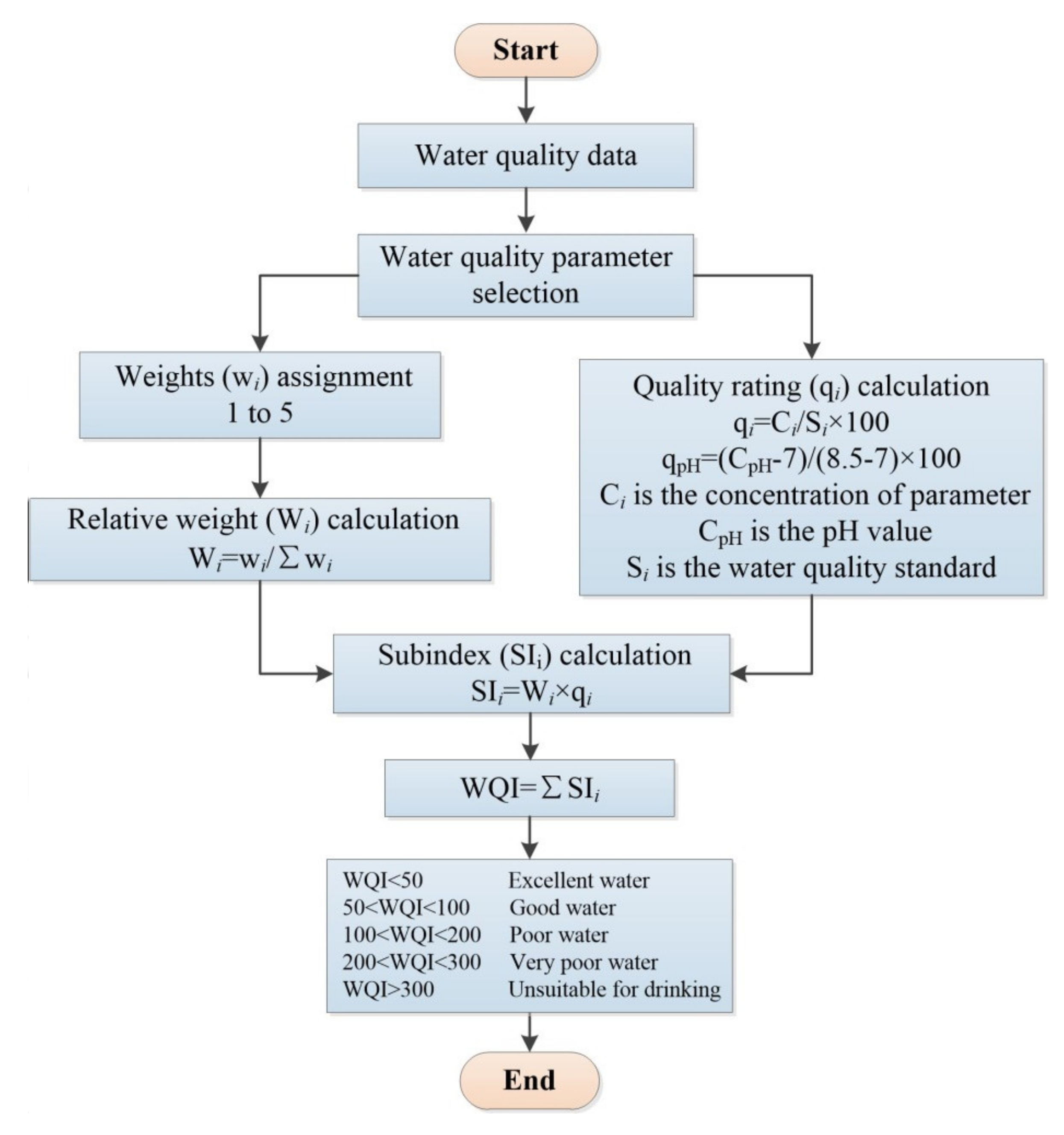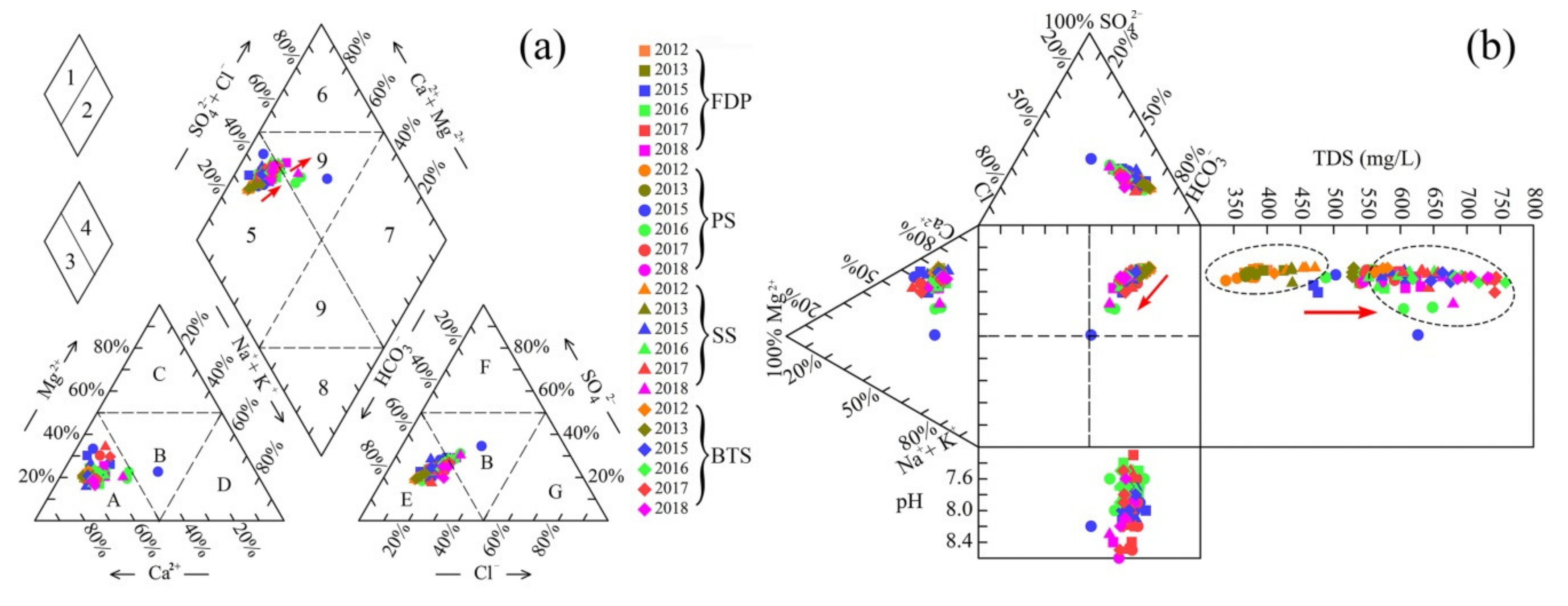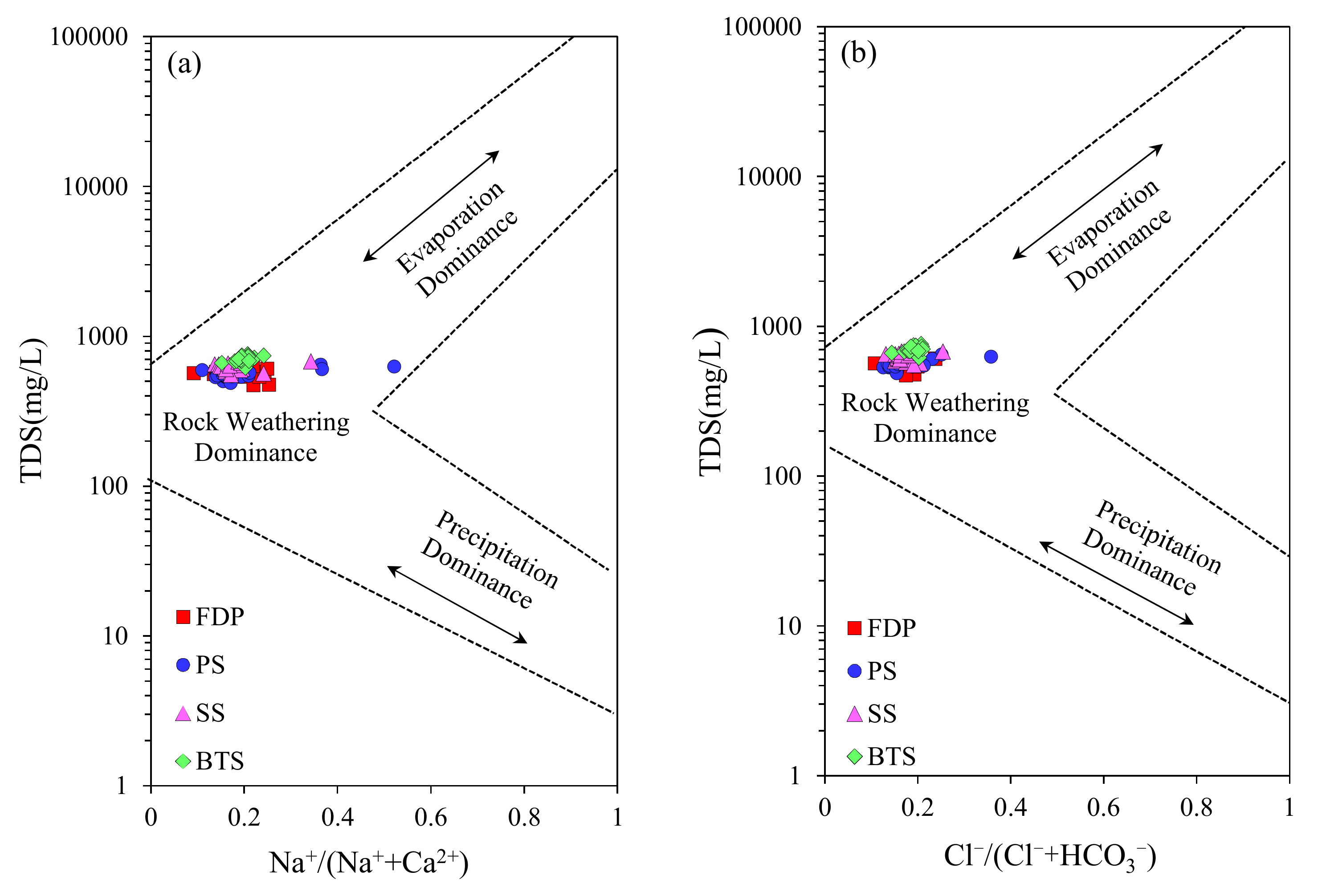Temporal Variations of Spring Water in Karst Areas: A Case Study of Jinan Spring Area, Northern China
Abstract
:1. Introduction
2. Study Area
3. Materials and Methods
3.1. Sampling and Analyses
3.2. Methods
4. Results and Discussion
4.1. Spring Water Chemistry
4.2. Water Types
4.3. Spring Water Chemistry Formation Mechanisms
4.4. Principal Component Analysis
4.5. Temporal Variations of Spring Water Quality
4.6. Temporal Variations of Spring Water Discharge
- 1.
- Natural flowing stage (1958–1967)
- 2.
- Flowing transitional stage (1968–1980)
- 3.
- Flowing decline stage (1981–2002)
- 4.
- Flowing recovery stage (2003–2012)
4.7. Influencing Factors of Spring Water DynamicsF
4.7.1. Influencing Factors of Spring Water Quality
4.7.2. Influencing Factors of Spring Water Flow
5. Conclusions
Author Contributions
Funding
Acknowledgments
Conflicts of Interest
References
- Calligaris, C.; Mezga, K.; Slejko, F.F.; Urbanc, J.; Zini, L. Groundwater Characterization by Means of Conservative (δ18O and δ2H) and Non-Conservative (87Sr/86Sr) Isotopic Values: The Classical Karst Region Aquifer Case (Italy–Slovenia). Geosciences 2018, 8, 321. [Google Scholar] [CrossRef] [Green Version]
- Doctor, D. Hydrologic connections and dynamics of water movement in the classical karst (kras) aquifer: Evidence from frequent chemical and stable isotope sampling. Acta Carsologica 2008, 3, 101–123. [Google Scholar] [CrossRef] [Green Version]
- Xing, L.; Zhou, J.; Song, G.; Xing, X. Mixing ratio of recharging water sources for the four largest spring groups. Earth Sci. Front. 2018, 25, 260–272. [Google Scholar]
- Gao, Z.; Xu, J.; Wang, S.; Li, C.; Han, K.; Li, J.; Luo, F.; Ma, H. The distribution characteristics and hydrogeological significance of trace elements in karst water, Jinan, China. Earth Sci. Front. 2014, 21, 135–146. [Google Scholar]
- Yin, X.; Wang, Q.; Feng, W. Hydro-Chemical and isotopic study of the karst spring catchment in Jinan. Acta Geol. Sin. 2017, 91, 1651–1660. [Google Scholar]
- Yang, L.; Liu, C.; Qi, X. Study on characteristic variation of hydro-chemistry of Jinan spring. J. Water Resour. Water Eng. 2016, 27, 59–64. [Google Scholar]
- Liu, S.; Sun, Z.; Liu, S. Survey on the spring water quality, Jinan City, 2012. Prev. Med. Trib. 2013, 19, 926–927. [Google Scholar]
- Yang, L.; Ye, H.; Tong, Z.; Liu, C.; Shang, H. Research of the impact of major construction projects to Jinan spring. Geotech. Investig. Surv. 2012, 40, 42–48. [Google Scholar]
- Wang, J.; Jin, M.; Wang, J.; Jin, M. Hydrochemical Characteristics and Formation Causes of Karst Water in Jinan Spring Catchment. Earth Sci. 2017, 42, 821–831. [Google Scholar]
- Lu, H.; Zhang, C. The variations of goundwater quality and its relationship with human activity. Res. Soil Water Conserv. 2007, 6, 238–240. [Google Scholar]
- Bo, K.; Cai, Y. Evaluation on groundwater pollution degree in Jinan karst area. Shandong Land Resour. 2016, 32, 51–55. [Google Scholar]
- Meng, X.; Wang, Q.; Lian, Y. Hydro-chemical dynamic characteristic analysis on springs in Jinan City. Shandong Land Resour. 2017, 33, 47–53. [Google Scholar]
- Zhang, Z.; Wang, W.; Qu, S.; Huang, Q.; Liu, S.; Xu, Q.; Ni, L. A new perspective to explore the hydraulic connectivity of karst aquifer system in Jinan spring catchment, China. Water 2018, 10, 1368. [Google Scholar] [CrossRef] [Green Version]
- Qi, X.; Yang, L.; Han, Y.; Shang, H.; Liting, X. Cross wavelet analysis of groundwater level regimes and precipitation groundwater level regime in Jinan spring region. Adv. Earth Sci. 2012, 27, 969–978. [Google Scholar]
- Zhou, J.; Xing, L.T.; Zhang, F.J.; Han, Z.; Peng, T.Q.; Xu, M.T.; Yang, Y. Chemical characteristics research on karst water in Jinan spring area. Adv. Mater. Res. 2015, 1092–1093, 593–596. [Google Scholar] [CrossRef]
- Wu, Q.; Xu, H. A three-dimensional model and its potential application to spring protection. Environ. Geol. 2005, 48, 551–558. [Google Scholar] [CrossRef]
- Wang, X.; Wang, C.; Wang, B.; Liu, S.; Song, J. Protection of urban features during urbanization based on the roles of springs in Jinan. Chin. J. Popul. Resour. Environ. 2017, 15, 93–102. [Google Scholar] [CrossRef]
- Qian, J.; Zhan, H.; Wu, Y.; Li, F.; Wang, J. Fractured-karst spring-flow protections: A case study in Jinan, China. Hydrogeol. J. 2006, 14, 1192. [Google Scholar] [CrossRef]
- Şener, Ş.; Şener, E.; Davraz, A. Evaluation of water quality using water quality index (WQI) method and GIS in Aksu River (SW-Turkey). Sci. Total Environ. 2017, 584–585, 131–144. [Google Scholar]
- Varol, S.; Davraz, A. Evaluation of the groundwater quality with WQI (Water Quality Index) and multivariate analysis: A case study of the Tefenni plain (Burdur/Turkey). Environ. Earth Sci. 2015, 73, 1725–1744. [Google Scholar] [CrossRef]
- Wu, Z.; Wang, X.; Chen, Y.; Cai, Y.; Deng, J. Assessing river water quality using water quality index in Lake Taihu Basin, China. Sci. Total Environ. 2018, 612, 914–922. [Google Scholar] [CrossRef] [PubMed]
- Liu, J.; Gao, Z.; Wang, M.; Li, Y.; Yu, C.; Shi, M.; Zhang, H.; Ma, Y. Hydrochemical and isotopic characteristics of surface water in the Lhasa River basin. Arab. J. Geosci. 2019, 12, 520. [Google Scholar] [CrossRef]
- Liu, J.; Gao, Z.; Wang, M.; Li, Y.; Ma, Y.; Shi, M.; Zhang, H. Study on the dynamic characteristics of groundwater in the valley plain of Lhasa City. Environ. Earth Sci. 2018, 77, 646. [Google Scholar] [CrossRef]
- Ministry of Natural Resources of the People’s Republic of China. Standard for Groundwater Quality of China; Ministry of Natural Resources of the People’s Republic of China: Beijing, China, 2017.
- WHO. Guidelines for Drinking Water Quality; World Health Organization: Geneva, Switzerland, 2008. [Google Scholar]
- Sarikhani, R.; Dehnavi, A.G.; Ahmadnejad, Z.; Kalantari, N. Hydrochemical characteristics and groundwater quality assessment in Bushehr Province, SW Iran. Environ. Earth Sci. 2015, 74, 6265–6281. [Google Scholar] [CrossRef]
- Piper, A. A graphic procedure in the geochemical interpretation of water-analyses. Eos. Trans. Am. Geophys. Union 1944, 25, 914–928. [Google Scholar] [CrossRef]
- Durov, S. Classification of natural waters and graphic presentation of their composition. Dokl Akad Nauk SSSR 1948, 1, 87–89. [Google Scholar]
- Liu, J.; Gao, Z.; Wang, M.; Li, Y.; Shi, M.; Zhang, H.; Ma, Y. Hydrochemical characteristics and possible controls in the groundwater of the Yarlung Zangbo River Valley, China. Environ. Earth Sci. 2019, 78, 76. [Google Scholar] [CrossRef]
- Qu, B.; Zhang, Y.; Kang, S.; Sillanpää, M. Water quality in the Tibetan Plateau: Major ions and trace elements in rivers of the “Water Tower of Asia”. Sci. Total Environ. 2019, 649, 571–581. [Google Scholar] [CrossRef]
- Gibbs, R.J. Mechanisms controlling world water chemistry. Science 1970, 170, 1088–1090. [Google Scholar] [CrossRef]
- Liu, J.; Hao, Y.; Gao, Z.; Wang, M.; Liu, M.; Wang, Z.; Wang, S. Determining the factors controlling the chemical composition of groundwater using multivariate statistics and geochemical methods in the Xiqu coal mine, North China. Environ. Earth Sci. 2019, 78, 364. [Google Scholar] [CrossRef]
- Yang, Q.; Li, Z.; Ma, H.; Wang, L.; Martín, J.D. Identification of the hydrogeochemical processes and assessment of groundwater quality using classic integrated geochemical methods in the Southeastern part of Ordos basin, China. Environ. Pollut. 2016, 218, 879–888. [Google Scholar] [CrossRef] [PubMed]
- Mostaza Colado, D.; Carreño Conde, F.; Rasines Ladero, R.; Iepure, S. Hydrogeochemical characterization of a shallow alluvial aquifer: 1 baseline for groundwater quality assessment and resource management. Sci. Total Environ. 2018, 639, 1110–1125. [Google Scholar] [CrossRef] [PubMed]
- Xiao, J.; Jin, Z.; Zhang, F.; Wang, J. Solute geochemistry and its sources of the groundwaters in the Qinghai Lake catchment, NW China. J. Asian Earth Sci. 2012, 52, 21–30. [Google Scholar] [CrossRef]
- Liu, P.; Hoth, N.; Drebenstedt, C.; Sun, Y.; Xu, Z. Hydro-geochemical paths of multi-layer groundwater system in coal mining regions—Using multivariate statistics and geochemical modeling approaches. Sci. Total Environ. 2017, 601, 1–14. [Google Scholar] [CrossRef]
- Karroum, M.; Elgettafi, M.; Elmandour, A.; Wilske, C.; Himi, M.; Casas, A. Geochemical processes controlling groundwater quality under semi arid environment: A case study in central Morocco. Sci. Total Environ. 2017, 609, 1140–1151. [Google Scholar] [CrossRef] [PubMed]
- Huang, Q.; Qin, Q.; Liu, Y.; Cheng, R.; Li, F. Regional evolution and control factors of karst groundwater in Liulin spring catchment. China Environ. Sci. 2019, 40, 2132–2142. [Google Scholar]
- Qian, J.; Peng, Y.; Zhao, W.; Ma, L.; He, X.; Lu, Y. Hydrochemical processes and evolution of karst groundwater in the northeastern Huaibei Plain, China. Hydrogeol. J. 2018, 26, 1721–1729. [Google Scholar] [CrossRef]
- Duan, S.; Jiang, Y.; Zhang, Y.; Zeng, Z.; Wang, Z.; Wu, W.; Peng, X.; Liu, J. Sources of nitrate in groundwater and its environmental effects in karst trough valleys: A case study of an underground river system in the Longfeng trough valley, Chongqing. Environ. Sci. 2019, 40, 1715–1725. [Google Scholar]
- Zhang, G.; Fei, Y.; Yang, L.; Hao, M.; Shen, J. Responses of groundwater recharge and pumpage to change in precipitation in Hebei plain. Earth Sci. J. China U Geosci. 2006, 6, 879–884. [Google Scholar]

















| Header | pH | TH | TDS | K+ | Na+ | Ca2+ | Mg2+ | HCO3− | SO42− | Cl− | NO3− | F− | NO2− | COD | H2SiO3 | SI (Calcite) | SI (Dolomite) | SI (Gypsum) | SI (Halite) | |
|---|---|---|---|---|---|---|---|---|---|---|---|---|---|---|---|---|---|---|---|---|
| FDP | Max | 8.4 | 369.66 | 630.66 | 1.50 | 35.00 | 114.90 | 28.29 | 271.17 | 105.66 | 66.21 | 41.57 | 0.25 | 0.05 | 1.15 | 20.10 | 1.33 | 2.26 | −1.50 | −7.22 |
| Min | 7.3 | 263.64 | 469.44 | 0.90 | 10.00 | 72.23 | 14.83 | 182.80 | 59.92 | 32.57 | 31.23 | 0.17 | 0.00 | 0.36 | 14.66 | 0.27 | 0.11 | −1.80 | −8.07 | |
| Mean | 7.89 | 331.47 | 566.60 | 1.11 | 21.45 | 99.95 | 19.88 | 244.86 | 81.23 | 46.14 | 37.47 | 0.21 | 0.01 | 0.71 | 17.50 | 0.82 | 1.28 | −1.62 | −7.61 | |
| SD | 0.31 | 29.74 | 40.85 | 0.15 | 6.03 | 10.31 | 3.11 | 24.51 | 9.67 | 7.43 | 2.89 | 0.02 | 0.01 | 0.24 | 1.24 | 0.29 | 0.60 | 0.07 | 0.19 | |
| Cv (%) | 3.88 | 8.97 | 7.21 | 13.89 | 28.12 | 10.31 | 15.65 | 10.01 | 11.91 | 16.11 | 7.70 | 11.31 | 121.16 | 33.24 | 7.09 | |||||
| PS | Max | 8.6 | 376.28 | 648.57 | 3.10 | 77.60 | 112.30 | 32.64 | 261.23 | 145.87 | 100.03 | 38.74 | 0.51 | 0.13 | 1.80 | 20.01 | 1.39 | 2.41 | −1.45 | −6.69 |
| Min | 7.6 | 280.25 | 488.22 | 1.00 | 12.00 | 71.12 | 15.50 | 179.76 | 56.48 | 36.68 | 15.96 | 0.18 | 0.00 | 0.36 | 10.06 | 0.48 | 0.64 | −1.81 | −7.81 | |
| Mean | 7.98 | 320.47 | 561.14 | 1.42 | 25.59 | 95.19 | 20.10 | 238.71 | 82.36 | 49.91 | 33.80 | 0.24 | 0.02 | 0.78 | 16.73 | 0.87 | 1.41 | −1.64 | −7.54 | |
| SD | 0.27 | 22.45 | 39.65 | 0.60 | 16.14 | 9.03 | 3.93 | 20.94 | 23.71 | 15.68 | 5.18 | 0.08 | 0.03 | 0.32 | 2.47 | 0.25 | 0.48 | 0.09 | 0.31 | |
| Cv (%) | 3.38 | 7.01 | 7.07 | 42.38 | 63.06 | 9.49 | 19.56 | 8.77 | 28.78 | 31.42 | 15.32 | 32.34 | 130.94 | 40.80 | 14.73 | |||||
| SS | Max | 8.5 | 401.23 | 679.53 | 2.70 | 52.80 | 125.00 | 35.97 | 287.60 | 132.08 | 82.76 | 47.61 | 0.27 | 0.13 | 1.41 | 21.42 | 1.45 | 2.49 | −1.43 | −6.95 |
| Min | 7.5 | 316.33 | 552.32 | 0.80 | 18.00 | 94.45 | 14.83 | 214.17 | 61.40 | 42.35 | 31.90 | 0.18 | 0.00 | 0.46 | 14.30 | 0.51 | 0.62 | −1.69 | −7.70 | |
| Mean | 7.90 | 361.51 | 622.11 | 1.33 | 24.43 | 110.28 | 20.91 | 263.06 | 89.83 | 53.86 | 43.44 | 0.20 | 0.01 | 0.79 | 18.38 | 0.92 | 1.46 | −1.55 | −7.49 | |
| SD | 0.28 | 25.23 | 36.44 | 0.50 | 7.50 | 9.32 | 4.43 | 21.75 | 14.65 | 8.07 | 4.20 | 0.02 | 0.03 | 0.25 | 2.00 | 0.30 | 0.60 | 0.07 | 0.15 | |
| Cv (%) | 3.53 | 6.98 | 5.86 | 37.29 | 30.71 | 8.45 | 21.17 | 8.27 | 16.31 | 14.98 | 9.66 | 9.67 | 230.89 | 31.44 | 10.89 | |||||
| BTS | Max | 8.5 | 438.89 | 757.95 | 2.40 | 35.75 | 136.13 | 35.97 | 314.31 | 121.13 | 78.17 | 56.63 | 0.23 | 0.05 | 6.49 | 21.54 | 1.52 | 2.61 | −1.40 | −7.17 |
| Min | 7.5 | 355.22 | 618.78 | 1.00 | 22.22 | 109.84 | 18.65 | 231.12 | 79.25 | 48.86 | 46.97 | 0.18 | 0.00 | 0.49 | 16.13 | 0.57 | 0.72 | −1.56 | −7.55 | |
| Mean | 7.88 | 404.55 | 701.01 | 1.23 | 30.83 | 124.75 | 22.59 | 282.33 | 104.40 | 66.73 | 52.60 | 0.20 | 0.00 | 1.11 | 19.05 | 0.94 | 1.48 | −1.46 | −7.28 | |
| SD | 0.27 | 21.79 | 36.43 | 0.30 | 3.44 | 7.76 | 3.73 | 18.45 | 9.68 | 7.19 | 2.63 | 0.01 | 0.01 | 1.29 | 1.58 | 0.26 | 0.52 | 0.05 | 0.10 | |
| Cv (%) | 3.43 | 5.39 | 5.20 | 24.15 | 11.16 | 6.22 | 16.49 | 6.54 | 9.27 | 10.78 | 5.01 | 6.49 | 223.42 | 116.24 | 8.27 |
| Variables | Principal Components | |||
|---|---|---|---|---|
| PC1 | PC2 | PC3 | PC4 | |
| Ca2+ | 0.966 | −0.001 | −0.106 | −0.064 |
| TH | 0.945 | 0.056 | 0.23 | −0.088 |
| NO3− | 0.919 | −0.189 | 0.089 | −0.060 |
| TDS | 0.880 | 0.407 | 0.222 | −0.073 |
| HCO3− | 0.816 | −0.149 | 0.184 | −0.252 |
| Na+ | 0.094 | 0.948 | 0.129 | 0.109 |
| Cl− | 0.450 | 0.808 | 0.237 | 0.096 |
| K+ | −0.224 | 0.787 | −0.105 | 0.084 |
| SO42− | 0.437 | 0.755 | 0.196 | 0.004 |
| H2SiO3 | 0.420 | −0.537 | −0.001 | −0.075 |
| F− | −0.482 | 0.175 | 0.197 | −0.120 |
| Mg2+ | 0.228 | 0.145 | 0.826 | −0.079 |
| COD | 0.028 | 0.101 | 0.809 | 0.090 |
| pH | −0.042 | 0.034 | 0.234 | 0.820 |
| NO2− | −0.219 | 0.104 | −0.224 | 0.635 |
| Eigenvalue | 5.074 | 3.900 | 1.757 | 1.223 |
| Variance (%) | 33.83 | 25.999 | 11.71 | 8.152 |
| Cumulative of variance (%) | 33.83 | 59.829 | 71.539 | 79.691 |
| Parameters | WHO Standards (2008) [23] | Weight (wi) | Relative Weight (Wi) |
|---|---|---|---|
| K+ | 12 | 2 | 0.0408 |
| Na+ | 200 | 3 | 0.0612 |
| Ca2+ | 300 | 2 | 0.0408 |
| HCO3− | — | 2 | 0.0408 |
| Mg2+ | 30 | 2 | 0.0408 |
| Cl− | 250 | 4 | 0.0816 |
| SO42− | 250 | 4 | 0.0816 |
| F− | 1.5 | 5 | 0.1020 |
| NO2− | 3 | 5 | 0.1020 |
| NO3− | 50 | 5 | 0.1020 |
| TH | 500 | 3 | 0.0612 |
| COD | 10 | 4 | 0.0816 |
| TDS | 1500 | 4 | 0.0816 |
| pH | 6.5–8.5 | 4 | 0.0816 |
| ∑wi = 49 | ∑Wi = 1 |
© 2020 by the authors. Licensee MDPI, Basel, Switzerland. This article is an open access article distributed under the terms and conditions of the Creative Commons Attribution (CC BY) license (http://creativecommons.org/licenses/by/4.0/).
Share and Cite
Gao, Z.; Liu, J.; Xu, X.; Wang, Q.; Wang, M.; Feng, J.; Fu, T. Temporal Variations of Spring Water in Karst Areas: A Case Study of Jinan Spring Area, Northern China. Water 2020, 12, 1009. https://doi.org/10.3390/w12041009
Gao Z, Liu J, Xu X, Wang Q, Wang M, Feng J, Fu T. Temporal Variations of Spring Water in Karst Areas: A Case Study of Jinan Spring Area, Northern China. Water. 2020; 12(4):1009. https://doi.org/10.3390/w12041009
Chicago/Turabian StyleGao, Zongjun, Jiutan Liu, Xingyong Xu, Qingbing Wang, Min Wang, Jianguo Feng, and Tengfei Fu. 2020. "Temporal Variations of Spring Water in Karst Areas: A Case Study of Jinan Spring Area, Northern China" Water 12, no. 4: 1009. https://doi.org/10.3390/w12041009
APA StyleGao, Z., Liu, J., Xu, X., Wang, Q., Wang, M., Feng, J., & Fu, T. (2020). Temporal Variations of Spring Water in Karst Areas: A Case Study of Jinan Spring Area, Northern China. Water, 12(4), 1009. https://doi.org/10.3390/w12041009







